
Use of this website constitutes acceptance of the Privacy Policy and User Agreement. Copyright © 2020 Kalimba Magic. All Rights Reserved.
One of the beautiful things about a typical kalimba is that it only has the “right notes.” Most kalimbas spell out a particular scale, and every note is a good note for expressing a certain range of music. The downside of that typical kalimba is that it cannot play music that requires chromatic notes (sharps and flats) outside of its particular key or scale.
Enter the chromatic kalimba with its many tines and wide capabilities. In order to maintain the general simplicity of playing most kalimbas, the “naturals” are on the front side and the “flats” are on the back side of this kalimba. Becoming skilled on the chromatic can take a lot of work and time, but meanwhile, there are thousands of songs you can play with just the front notes, and we do have three fantastic downloads that happen to nicely suit the front side of your Treble Chromatic Kalimba.
Let me say that another way just to emphasize: Even if you are a novice player, you can get a Treble Chromatic kalimba and mainly learn on the front side. As you advance, you can slowly ease yourself into playing the Chromatic’s back-side notes.
The front side of the Treble Chromatic kalimba is set up and painted just like the Alto kalimba, except that the Treble Chromatic is a 4th higher… and the Treble Chromatic has two extra notes, one on the far left and one on the far right. The main advantage to this setup is that, owing to their identical tine-painting schemes, someone who has played the Alto kalimba, the Bb Treble kalimba, or a 17-Note kalimba in C can just pick up a Treble Chromatic and start playing all the songs they know from any of those other, non-chromatic kalimbas.
As such, you can use the tablature from any of Kalimba Magic’s Alto books to learn a song on the front side of your Treble Chromatic. It’s not totally straightforward though. You won’t be able to play along with the recordings because they were made in the key of G while the chromatic kalimba’s front side is in C. Rather, listen to the recording in G while you follow along with the tablature. You can even do this with your Treble Chromatic in your hands, touching the tines as they are to be played… but don’t play them. Then when the MP3 is done playing, play your kalimba from the tablature. If you practice these steps then the different keys will not be an impossible obstacle.
The great news for you is this: As a response to the popularity of the new Chinese-made 17-note kalimbas, I created three high quality downloads for the 17-Note Kalimba in C – which will work perfectly for the front-side notes your Treble Chromatic, and are accompanied by great sound recordings to help you perfect your playing.
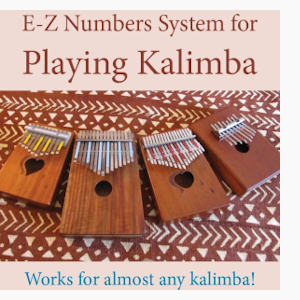
This numbers-based ebook (download) works with essentially any kalimba. It shows you which tines you need to mark with numbers – use a Sharpie pen. For 6-notes, 8-notes, 10-notes, 15-notes, and 17-note kalimbas… and probably for every other kalimba in between. If you feel that kalimba tablature is beyond you, try starting here.
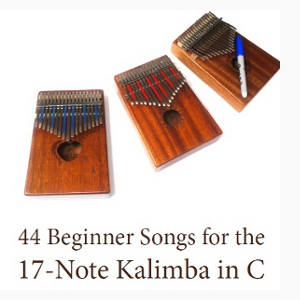
This is a 62-page, PDF ebook with live links to MP3 files for each song. This is a great way to learn to play the 17-Note Kalimba in C. Contains children’s songs, “Shenandoah,” “Beautiful Dreamer,” “Ode to Joy,” “You Are My Sunshine,” “God Bless America,” “Nobody Knows the Trouble I’ve Seen,” “My Country ‘Tis of Thee,” and more.
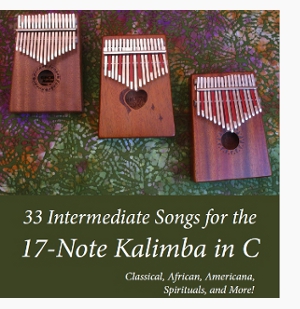
An 82-page, PDF ebook with live links. This is a great next step for learning the 17-Note Kalimba in C after you have worked through most of the “44 Beginner Songs” or “Easy Christmas Carols” ebooks. Songs include “Bach’s Minuet,” “Finlandia,” “Jesu, Joy of Man’s Desiring,” “Shumba Panzira,” “Chemtengure,” “Suwannee River,” “Wayfarin’ Stranger,” “We Shall Overcome,” “Hard Times Come Again No More,” “Marine’s Hymn,” “De Colores,” “Swing Low Sweet Chariot,” “O Danny Boy,” and more.

A 54-page, PDF ebook with live links. This is a great collection of music in the traditions of American folk, spirituals, and patriotic music. Songs rated between Level 0 and Level 4. Of the 29 songs, 18 are Level 0, 1, or 2, making this a good option for beginning kalimba players.
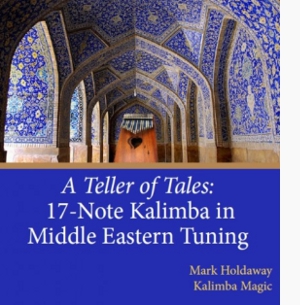
This Middle Eastern tuning makes amazingly beautiful, powerful, exotic music. It is really a journey I can recommend to most anyone. The music you can play in this kalimba tuning takes you around the world in its musical expressions. I find this music to be so beautiful that I recommend you purchase the download just to listen to the recordings that come with, even if you don’t play kalimba.
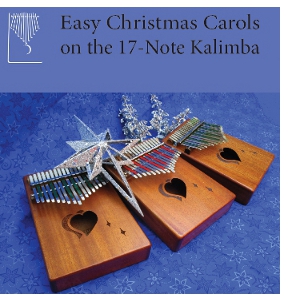
This 82-page PDF ebook is a delightful way to learn to play the 17-Note Kalimba in C. It starts out with simple melodies and progresses by adding more harmony notes as you make your way through the book. 28 songs (there are multiple versions of some songs). You likely have known most of these songs since you were a child: “Silent Night,” “The First Noel,” “O Christmas Tree,” “Jingle Bells,” “O Come All Ye Faithful,” “Deck the Halls,” “Away in a Manger,” “Carol of the Bells,” and more.
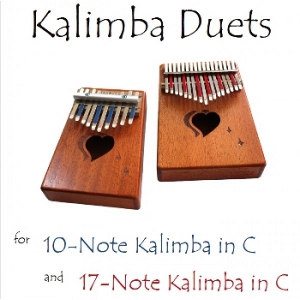
This ebook is a PDF file with live links to the sound files that will illustrate how each song is supposed to sound, for the 10-Note, the 17-Note, and for the two kalimbas together. Seventy pages, including 22 duets for the 10-Note kalimba in C and the 17-Note kalimba in C.
This book of duets gives you several great ideas for how two kalimbas can fit together to make music, from unison and simple thirds harmony to continuo, counterpoint, hocket, kushaura and kitsinhira parts… and rounds. Great fun, with an emphasis on how to create beautiful music with mostly simple parts working together.

An 39-page, PDF ebook with live links to the MP3 files. Each of 12 songs are presented in both a basic version and an advanced version. The basic versions tend to be melody-only, or with a little bit of harmony. The advanced versions have full harmony, counterpoint, multiple melody lines, etc – enough to keep you busy for many Easters to come. Includes: “All Creatures of our God and King,” “Lord of the Dance,” “Holy, Holy, Holy,” “Joyful, Joyful, We Adore Thee,” and “This is My Father’s World.”
In summary: the Treble Chromatic Kalimba is a powerful instrument, capable of essentially any song, any melody, and any harmony (within its range limitations). But it is also a challenging instrument when played in its full chromatic glory. If you ever feel overwhelmed by the possibilities of the instrument, you can take a little vacation on just the front side, and play simple songs again. And Kalimba Magic is there with ample instructional material to get you started.


Sign up for our newsletter and free resources with your email address:
We pinky promise not to spam you and to only send good stuff.
 Assist Paul Tracey Rebuild His House in Pacific Palisades
Assist Paul Tracey Rebuild His House in Pacific Palisades 8-Note Spiral Kalimba Turned into a Student Karimba
8-Note Spiral Kalimba Turned into a Student Karimba Seek to Infuse Your Musical Moments With Beauty and Magic
Seek to Infuse Your Musical Moments With Beauty and MagicUse of this website constitutes acceptance of the Privacy Policy and User Agreement. Copyright © 2020 Kalimba Magic. All Rights Reserved.